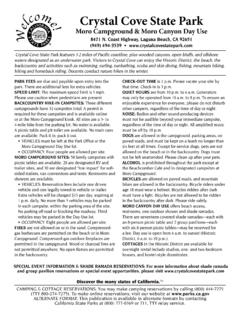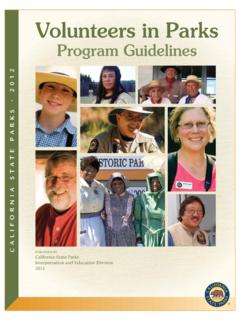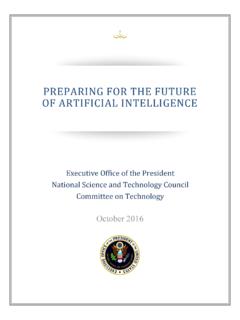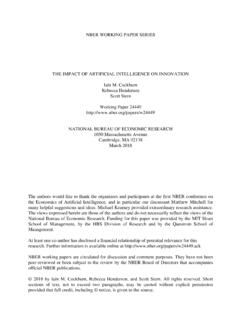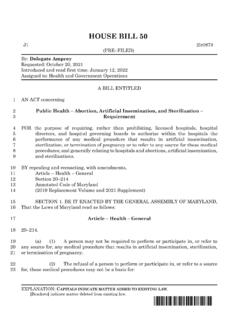Transcription of Guide to the California Dairy Industry History Collection
1 Guide to the California Dairy Industry History Collection Guide to the California Dairy Industry History Collection Contact Information: California State Parks Department Archives 1416 9th Street, Room 943. Sacramento, CA 95814. Phone: (916) 651-6959. Fax: (916) 653-3398. Project Manager: Victoria Yturralde, Archivist, California State Parks Processed by: Larry Bishop Encoded by: Larry Bishop and Denise Schaffer Date Completed: April 2005. Guide to the California Dairy Industry History Collection Table of Contents Descriptive Summary .. 1. Administrative 2. Organization and Processing Notes .. 3. A Brief History of the California Dairy Industry .. 5. Biographical Notes .. 9. 11. Bibliography .. 13. Collection Scope and Content 14. Indexing Terms .. 16. Collection Contents .. 17. Series I. Organizations .. 17. Series II. Companies and Cooperatives .. 29. Series III. California Dairy 33. Series IV. Equipment and Machinery .. 44. Series V. Legislation, Regulation, and Government 48.
2 Series VI. 53. Series VII. Photographic Materials .. 55. ii Guide to the California Dairy Industry History Collection Descriptive Summary Collection Title Dairy Industry History Collection , 1856-1986 (bulk 1953-1978). Collection Number Consult repository Collectors Dairy Museum and Educational Foundation California State Parks Herman J. Grabow Neil McPherson Extent cu. ft. in 52 boxes, and linear feet of bound journals. Repository California State Parks. Department Archives. 1416 9th Street, Room 943, Sacramento, California 95814. Abstract The Dairy Industry History Collection contains documentary items extracted from a large assemblage of materials collected for use at an anticipated California Dairy Museum. Between 1976 and 1981 California State Parks, in cooperation with the California Dairy Museum and Educational Foundation (CDMEF), participated in a joint venture to create a museum at Wilder Ranch State Park in Santa Cruz County. The museum was intended to showcase the contributions of the Dairy Industry to the social and economic development of California .
3 In 1976 the CDMEF. donated its Collection of Dairy machinery, equipment, and archival materials to the California State Parks. The foundation also established an advisory committee to assist California State Parks in managing the Collection and in locating and acquiring additional materials for the proposed museum. In 1981 the State Parks Commission voted not to fund the museum, and the Collection went into storage first at Wilder Ranch State Park and then at the State Museum Resources Center in West Sacramento. The archival Collection described in this Guide covers the period of 1856 to 1986 with the bulk of the material dating from 1930 to 1978. 1. Guide to the California Dairy Industry History Collection Administrative Information Access This Collection is open for research. Accruals Additional material may be added to this Collection as donations are received. Related Materials The Collection described in this finding aid represents only those materials that are archival in nature.
4 Artifacts (including large machinery) and other three-dimensional objects that were at one time identified by the accession number 085-2 are not included in this Guide . Publication Rights Property rights reside with California State Parks. Literary rights are retained by the creators of the records and their heirs. For permission to reproduce or to publish, please contact California State Parks. Preferred Citation [item], California Dairy Industry History Collection , California State Parks, Sacramento, California . 2. Guide to the California Dairy Industry History Collection Organization and Processing Notes The California Dairy Industry History Collection is an artificial Collection encompassing materials acquired from various sources. Since the California State Parks' acquisition of the bulk of this Collection from the California Dairy Museum and Educational Foundation in 1978, a variety of efforts were made to catalog and organize the material.
5 Unfortunately, none of these attempts resulted in the organizational or descriptive tools required to lend research functionality to the Collection . For example, a typed inventory of the Collection described items from McPherson's home, but the inventory is undated, the author is not stated, the material was not arranged, and only the contents of a single box of documents were described. In addition, the Collection has been relocated more than once, and shows evidence of having been repackaged and resorted, eliminating the possibility of reassembling the order created by the original collector(s). It is also likely that items were added to the Collection between 1977 and 2002, and records of these accruals, where present, have not been maintained or preserved. These factors, as well as the undocumented provenance of the materials, resulted in the decision to process the Collection as a single entity. The total absence of a usable original order necessitated the imposition of a new overall arrangement to improve accessibility and facilitate locating, retrieving, and filing the materials.
6 Researchers may note what appear to be discrepancies or omissions in this finding aid regarding the numbering conventions used for boxes in the Collection . To maintain an effective intellectual arrangement of the material, all items are listed within the context of the series or subseries they relate to, despite having been physically relocated because of size, format, or preservation need. The notation Moved to Box [box number] guides the user to the material. The Collection has been organized into the following series and subseries: Series I: Organizations Subseries 1: American Dairy Association Subseries 2: California Dairy Industries Association Subseries 3: California Dairy Museum and Educational Foundation Subseries 4: California Milk Advisory Board Subseries 5: Dairy Council of California Subseries 6: University of California Subseries 7: Organizations, various Series II: Companies and Cooperatives 3. Guide to the California Dairy Industry History Collection Series III: California Dairy People Subseries 1: Herman J.
7 Grabow Papers Subseries 2: Neil McPherson Collection Subseries 3: Steel Family Papers Subseries 4: California Dairy People, various Series IV: Equipment and Machinery Series V: Legislation, Regulation, and Government Agencies Subseries 1: California State Assembly Subseries 2: California State Senate Subseries 3: California State Department of Agriculture Subseries 4: Various Legislative and Regulatory Offices and Committees Series VI: Publications Series VII: Photographic Material 4. Guide to the California Dairy Industry History Collection A Brief History of the California Dairy Industry Cattle first entered California with the Spanish missionaries in the late 1700's. Milk and cheese were consumed at the Franciscan Missions from San Diego to the northernmost mission at Sonoma. At times milk may even have been an essential element of the missionaries' diet. Father Junipero Serra wrote in 1772 that milk was their chief subsistence at Mission San Carlos in Carmel, and other records show that as early as 1776 women were making cheese and butter at Mission San Gabriel.
8 But the first cattle in California were of Mexican stock, better suited for meat, hide and tallow than for milk. As these herds grew, a lucrative trade in tallow and hides developed. These goods left California by ship, and the Eastern merchants' desire for these products in the 1830s contributed to the growth of seaport trading communities at San Diego, Santa Barbara, and Monterey. In the first few decades after the arrival of cattle in California , dairying was incidental to the more lucrative tallow and hide trades. But as the herds grew stronger and larger, dairying became more and more popular. The first export of Dairy products, however, probably happened much farther north than the centers of the tallow and hide trades. The Russians at Fort Ross on the Sonoma coast engaged in farming and dairying and shipped butter, cheese, and locally grown produce to fur-trapping settlements in Alaska between the years of 1812 and 1841. After the Russians left California in 1841, John Sutter of Sacramento acquired most of the materials at the fort, including the small Dairy herd, and he operated small dairies on land at Mills Station (modern- day Rancho Cordova, in the Sacramento area) and Yuba City.
9 But until the great influx of fortune seekers in the 1850's following the discovery of gold in California , dairying in the state was still primarily a domestic activity, and not an economic one. Many families who braved the overland trek from the eastern United States brought with them cows to provide milk for their children and infants. In the Mother Lode mining communities Dairy cattle soon became valuable commodities. In many cases, while husbands were mining, wives managed the family's livestock and found that they could sell fresh milk and butter at a favorable price. Dairy herds began appearing in the Sierra foothills to satisfy the Easterners' desire for milk and butter; simple pleasures that they had left behind when they decided to seek their fortunes in the untamed gold fields. As California 's population swelled over succeeding decades, the demand for milk increased proportionally. Fluid milk is more perishable than butter or cheese, so initially milk had to be produced within a short wagon ride of its consumers.
10 Larger Dairy herds first emerged close to California 's most populated areas to ensure that milk could be supplied to the rapidly growing urban populations. According to the 1860 census, there were 264,000 people in California and 104,000 cows, and the principal 5. Guide to the California Dairy Industry History Collection Dairy regions that year were the San Francisco Bay area and the Sacramento Valley. Because of the great demand for milk in San Francisco, and because of the area's good rainfall and natural pasturage, the Bay Area became the state's first major Dairy center. In the late 1850's dairies in Petaluma began shipping butter and cheese down the coast by ship to the San Francisco Bay area; however, this answered only a fraction of the demand at the time and the majority of Dairy products were still being shipped from the East Coast. California 's cheese and butter industries saw dramatic growth in the second half of the century. In 1850 only 705 pounds of butter and 150 pounds of cheese were produced in California , but by 1880.


